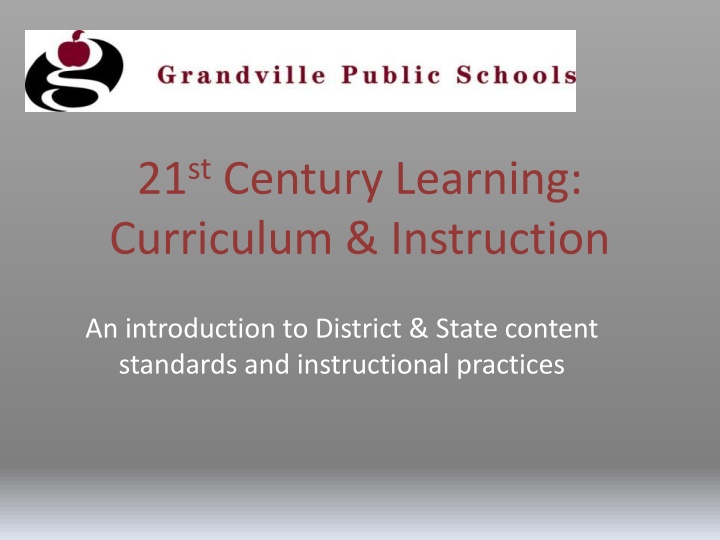
Modern Curriculum and Instruction: Enhancing Learning in the 21st Century
Explore the importance of aligning curriculum with state standards, emphasizing non-fiction reading, vocabulary development, and math practice shifts. Learn how early exposure to words and concepts shapes educational success.
Download Presentation

Please find below an Image/Link to download the presentation.
The content on the website is provided AS IS for your information and personal use only. It may not be sold, licensed, or shared on other websites without obtaining consent from the author. If you encounter any issues during the download, it is possible that the publisher has removed the file from their server.
You are allowed to download the files provided on this website for personal or commercial use, subject to the condition that they are used lawfully. All files are the property of their respective owners.
The content on the website is provided AS IS for your information and personal use only. It may not be sold, licensed, or shared on other websites without obtaining consent from the author.
E N D
Presentation Transcript
21stCentury Learning: Curriculum & Instruction An introduction to District & State content standards and instructional practices
MI State Standards a little background: They are aligned with college and work expectations. Are clear, understandable and consistent. Include rigorous content and application of knowledge through higher order skills. Build on current state standards, but are intended to be fewer and in more depth. Are evidence based.
Six Shifts in ELA/Literacy Source: engageNY, New York Dept. of Education 1. Read as much non-fiction as fiction, or more as they get older. 1. 4thgrade: 50-50%, 8thgd.: 55/45%, 12thgd.: 70/30% 2. Learn about the world by reading. 3. Read more challenging material closely. 4. Discuss reading using evidence. 5. Write non-fiction using evidence. 6. Increase academic vocabulary.
The Power of Vocabulary and Early Reading Skills By age 3, children from affluent families have heard 30 million more words than children from parents living in poverty (Hart and Risley, 1995). Children with larger vocabularies and greater understanding of spoken language do better in school (Whitehurst and Lonigan). Children who are not reading at grade level by 3rd grade are four times more likely to leave high school without a diploma (Hernandez, 2011).
Mathematics: Standards for Practice Source: Spotlight on the Common Core State Standards by Education Northwest, March 2011 1. Make sense of problems and persevere in solving them. 2. Reason abstractly and quantitatively. 3. Construct viable arguments and critique the reasoning of others. 4. Model with mathematics. 5. Use appropriate tools strategically. 6. Attend to precision. 7. Look for and make use of structure. 8. Look for and express regularity in repeated reasoning.
Math Shift #1: Learn more about less Students will Spend more time on fewer concepts. Develop deeper conceptual understanding. Need to show understanding of a variety solution methods. Recognize what works, what doesn t and explain it.
Math Shift #2: Know it really well, do it repeatedly Students will Understand why the math works, make the math work. Talk about why the math works. Prove that they know why and how the math works. Go beyond solving problems and following steps show it and explain it.
Math Shift #3: Real World Application Students will Apply math in real world situations. Know which math to use for which situation. Explain their rationale for solving problems and recognize/critique alternate solutions for accuracy.
A Summary of Math Shifts Students need to go beyond simply reciting math facts and following steps to solve problems. Less repetitive math facts and teacher guided multi-step problems. More application of math skill into problem based application. Students will be given problems to solve independently and in groups. More dialogue about how students solved problems. This allows students to explain their answers and critique/evaluate the accuracy of others solutions.
Wheres All the Homework? Research does not support positive impact of homework on achievement. Homework: An unnecessary evil? Surprising findings from new research, The Washington Post, 11/26/12. Reading appropriate leveled books is best. Math practice looks different: some digital some challenging tasks. Questions to ask when helping with homework: How do you know that? Why do you think that is correct? Explain your thinking.
Assessment Examples: what does this look like in practice? Sample 4thGd. Reading Question:
Resources Common Core State Standards www.corestandards.org Parent Roadmaps to the Common Core Standards from the Council of the Great City Schools www.cgcs.org/Domain/36 Common Core Standards Parent Handbook, by the California County Superintendents ESA, 2011 http://www.ocde.us/CommonCoreCA/Documents/CCSParentHa ndbook_020411.doc.pdf Parent Guides to the Common Core Standards by engageNY (NY State Education Dept) http://engageny.org/parent-guides-to-the-common-core- standards
